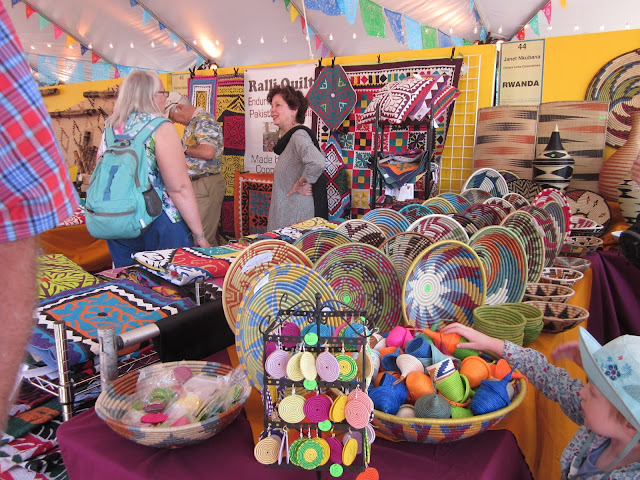Legend says that the Sisters of the Chapel made a novena to St. Joseph, the patron saint of carpenters. On the ninth and final day of prayer, a man appeared at the Chapel with a donkey and a toolbox looking for work. Months later, the elegant circular staircase was completed. It had two complete spirals without center or side supports. Upon completion, the carpenter disappeared without pay or thanks. It was originally built with no railings - those were added later.
The ornate stained glass in the Loretto Chapel made part of its journey to Santa Fe via wagon. Purchased in 1876 from the DuBois Studio in Paris, the glass was first sent from Paris to New Orleans by sailing ship and then by paddle boat to St. Louis, MO. where it was taken by covered wagon over the Old Santa Fe Trail to the Chapel. These are the original stained glass windows.
A few days later we visited the tiny community of Chimayo (pronounced Chim I O' with the accent on the O) located about 45 minutes north of Santa Fe. The village is well known for the chapel, the Santuario.
This is the chapel.
These rock arches represent the seven days of creation.
Very interesting artwork in the various buildings and courtyards.
Chimayo is also well known for the weavings done there. We visited two weaving places - many beautiful rugs, table runners, coasters, purses, clothing, etc. It was so interesting to see the weaving actually being done as we watched. I was told it takes about two days to "load" one of these looms, getting it ready for the weaving.
The man weaving this rug told me he makes up the pattern as he does the weaving. I can't even imagine doing that.
We spent part of a day in a historic coal mining town and ghost town named Madrid (with the accent on the Mad). It used to be a deserted town, but has been taken over and rejuvenated by hippies and has shops, restaurants, a spa and museum. The locals in Santa Fe call it Hippieville.
We learned the town has no sewer system, so every store has porta-potties. Also, the water there is icky so it has to be filtered before being used in homes and restaurants. Can't say any of us wanted to move right in!
The buildings are very old and have been repurposed as shops, restaurants, etc.
This plaque is on the building above, just to the left of the stairs.
Resident birds sitting on their nest in a corner above a shop door.
The driveway in front of a glass studio is "paved" with glass pieces. It reminded me of the sidewalk at Shipwreck Beads in Washington.
An interesting sculpture using old metal parts outside a store. How welcoming is that?
Our final stop in Santa Fe - two new "shoes" (tires) for the trailer at Garcia Tires. Very nice and accommodating folks. We couldn't get up to their shop, so they did the work in the street. It was a dead end street, so to turn around, we had to ask two big trucks to move, back up, pull into a McDonald's driveway, back up into the street then go forward!!! All us RVers know just what that is like.




















































